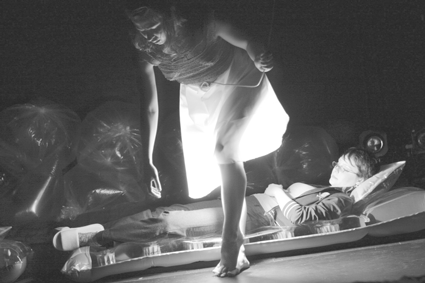John Jasperse’s “Prone” places viewers in the dance
I’m not sure that lying down is always more comfortable than sitting. Opening night at John Jasperse’s “Prone,” we’re asked to choose between the French air mattresses lined up in rows like a fantasy sleeper flight, and the chairs around the perimeter. First-comers tend to choose the mattresses; they look like part of the party, and the sidelines are for watching.
There is a wait before the performance begins during which we’re invited to mill around, unfasten our seatbelts as it were, and chat with friends. In a row of single end-to-end beds, I am virtually playing footsy with John Rockwell.
Eleanor Hullihan, Levi Gonzales, and Luciana Achugar start, dumping large inflated transparent bags off the stage into our cabin. Much is made of air in “Prone.” The dance production is deceptively simple, involving elaborate mechanism. For all its touchy, feely experientialism, our response is fully designed and choreographed. Zeena Parkins music, synched as if improvised, is composed. As in last year’s “California” by Jasperse, imagination is implicitly encouraged.
Site lines are not always ideal from the prone perspective, but Jasperse is ever vigilant to entertain as well as to move us from the known, the expected, the comfortable. Mostly he offers his gift of created fantasy, his desire for human connection, approaching the synapse where that happens with an almost scientific curiosity.
Artistry abounds as well. The dancers lie on the floor in one aisle and raise their hands. Brightly lit by Joe Levasseur, the dancing hands are like a puppet performance—a sort of show within the show.
They move with admirable care and workmanship, with constant transparent effort of body and mind. Their tread shows commendable trepidation and little presumption of certainty. Powerful moments of evocation come of this—and a steady pleasure in watching Gonzalez do little of anything and make a point.
In a coup d’ theatre as artful as it is awesome, Hullihan dresses in a skirt taken off a row of pendant fixtures hanging upstage—bulbs clothed in a silky, hopefully heat resistant drapery. She travels slowly stepping over the horizontal spectators, the bulb between her quivering legs looking dangerous, hot, and bright. Under her, the view is so intimate and surreal it cannot easily be forgotten.
But when the three shuffle across in inflated tutus, things cool down. The sandman, Jasperse, and his dancers give us beanbag sleep masks that have a sachet scent. Parkins’ live electric slide harp turns lullaby.
Like a bad dream however, the dancers stomp loudly. The sensation is frightening because we cannot see. There’s a mean streak in Jasperse, along with a gentle sexuality rarely seen so naked and true on the stage. I imagine most were not too pussy-whipped to peek.
In an intermission changeover, the sleepover party is guided to chairs and vice-versa. The second group of flat spectators is treated to a second coup, achieved with a circuitry of air. Jasperse’s visuals include specially designed mattresses. Protuberances suddenly inflate between our legs like joysticks, evincing unabashedly rising and swollen stumps. The artist offers an unsolicited experience. Regardless of gender, as with Hullihan’s solo with bulb, we’re given a sense what it must be like to have something between our legs. In “Prone” everyone gets an intimate view of what it must be like to be a dancer. They pile on top of each other, jostle, and push—usually as a group force, and very near or straddled over us. The effort, the risk, the friction in the raw sensation of flesh on flesh is given as we rarely see it.
During a rather long space walk, Parkins’ crescendo is like a 21st century “Purple Rain.” The exhausted dancers collapse and their breathing is amplified and augmented by Parkins, creating much needed moments of calm, comfort, and familiar rhythm.
gaycitynews.com



































